"Here is a first start after overhaul of a 4360. 28 cylinders, 7 magneto's, 56 spark plugs. This engine will go on a Corsair when finished.
Below, you will find a great test stand video of the Pratt & Whitney 4360 Wasp engine introduced in 1944. Basically, the engine was 28-cylinder four-row air cooled radial engine. Each row of pistons was slightly offset from the previous, forming a semi-helical arrangement to facilitate efficient airflow cooling of the successive rows of cylinders, with the spiraled cylinder setup inspiring the engine's "corncob" nickname. A mechanical supercharger geared at 6.374:1 ratio to engine speed provided forced induction, while the propeller was geared at 0.375:1 so that the tips did not reach inefficient speeds. Initially, it developed 3,000 horsepower, later models gave 3,500 horsepower. The 4360 powered the B-50, successor to the B-29 and later the B-36, to name a few. Although reliable in flight, the Wasp Major was maintenance-intensive. Improper starting technique could foul all 56 spark plugs which would require hours to clean or replace. As with most piston aircraft engines of the era, the of the Wasp Major was about 600 hours when used in commercial service."
Below, you will find a great test stand video of the Pratt & Whitney 4360 Wasp engine introduced in 1944. Basically, the engine was 28-cylinder four-row air cooled radial engine. Each row of pistons was slightly offset from the previous, forming a semi-helical arrangement to facilitate efficient airflow cooling of the successive rows of cylinders, with the spiraled cylinder setup inspiring the engine's "corncob" nickname. A mechanical supercharger geared at 6.374:1 ratio to engine speed provided forced induction, while the propeller was geared at 0.375:1 so that the tips did not reach inefficient speeds. Initially, it developed 3,000 horsepower, later models gave 3,500 horsepower. The 4360 powered the B-50, successor to the B-29 and later the B-36, to name a few. Although reliable in flight, the Wasp Major was maintenance-intensive. Improper starting technique could foul all 56 spark plugs which would require hours to clean or replace. As with most piston aircraft engines of the era, the of the Wasp Major was about 600 hours when used in commercial service."


Comment